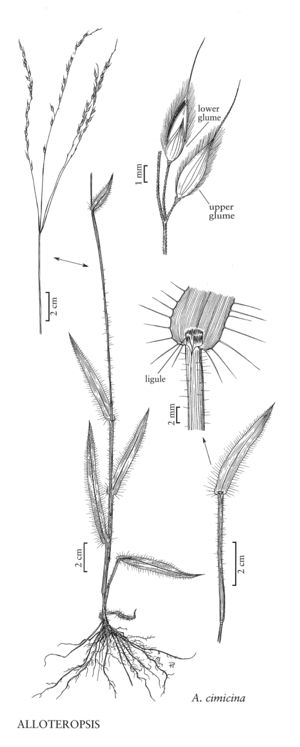Difference between revisions of "Alloteropsis cimicina"
Common names: Bugseed grass
Synonyms: Coridochloa cimicina unknown
Treatment appears in FNA Volume 25. Treatment on page 385.
FNA>Volume Importer |
FNA>Volume Importer |
||
| Line 20: | Line 20: | ||
-->{{Treatment/Body | -->{{Treatment/Body | ||
|distribution=Md.;Fla.;Miss. | |distribution=Md.;Fla.;Miss. | ||
| − | |discussion=<p>Alloteropsis cimicina is native to southeast Asia but has been collected in Alachua and Columbia counties, Florida, and Baltimore, Maryland. Being a weedy species, it should be sought at other disturbed locations along the east coast of the United States.</p> | + | |discussion=<p><i>Alloteropsis cimicina</i> is native to southeast Asia but has been collected in Alachua and Columbia counties, Florida, and Baltimore, Maryland. Being a weedy species, it should be sought at other disturbed locations along the east coast of the United States.</p> |
|tables= | |tables= | ||
|references= | |references= | ||
| Line 41: | Line 41: | ||
|publication year= | |publication year= | ||
|special status= | |special status= | ||
| − | |source xml=https://jpend@bitbucket.org/aafc-mbb/fna-data-curation.git/src/ | + | |source xml=https://jpend@bitbucket.org/aafc-mbb/fna-data-curation.git/src/8f726806613d60c220dc4493de13607dd3150896/coarse_grained_fna_xml/V25/V25_1095.xml |
|subfamily=Poaceae subfam. Panicoideae | |subfamily=Poaceae subfam. Panicoideae | ||
|tribe=Poaceae tribe Paniceae | |tribe=Poaceae tribe Paniceae | ||
Revision as of 16:28, 18 September 2019
Culms 15-75 cm. Sheaths hispid; ligules to 2 mm, membranous and ciliate; blades to 8 cm long, 15-25 mm wide, flat, cordate, hispid abaxially, glabrous adaxially, margins with papillose-based hairs. Panicles with 4-7 digitate branches; branches 2-16 cm. Spikelets 2.7-3.2 mm, subsessile; upper lemmas awned, awns 0.4-1.2 mm. 2n = 36.
Distribution
Md., Fla., Miss.
Discussion
Alloteropsis cimicina is native to southeast Asia but has been collected in Alachua and Columbia counties, Florida, and Baltimore, Maryland. Being a weedy species, it should be sought at other disturbed locations along the east coast of the United States.
Selected References
None.
Lower Taxa
None.
